FrequencyThe XB Owners Manual tells you to change the oil after:
1000 miles
5000 miles
10000 miles
Every 5000 miles thereafter
The general consencus is to change both Engine and Transmission Oils (and filter) every
2500 miles. Some forum members change the oil and filter every 1000 miles.
DrainingWarm the bike up. Best drained on the side stand. On removel of the plugs, do not be alarmed if there is plenty of "iron filings" on the transmission plug, especially if the bike is low milage. Just wipe it off before replacing the plug...
Kitchen foil can help your draining experience, a sheet with a fold in it can direct the oil away from the engine and exhaust.
Removing the filterThere are plenty of ways to remove the oil filter, list in order of heathen to supercivilised:
* Screwdriver and hammer (get that oil everywhere and ensure your screwdriver never goes rusty)


* Pliers

* Chains / belts / straps

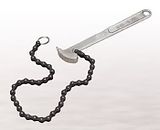


* Adjustable socket

* Dedicated socket (14 flutes, 65mm AF with a 17mm hex to drive it with...)
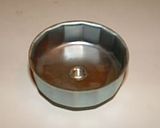

* By hand
I prefer the latter two methods.
When removing the filter, bear in mind that there is going to be a release of oil. Kitchen foil can help here, a sheet with a fold in it can direct the oil away from the engine and exhaust.
Filter choiceThe genuine Buell part is the filter of choice. There have been reports of filters working loose and leaking. Cheaper non-Buell filters may not have the correct thread. The Buell filter is 3/4"UNF, a 20mm will screw on which will probably give problems with it coming loose.... or worse still, blowing off....
Replacing filterFill the filter with 4 oz (0.12 litres) of fresh oil. Apply a thin smear of engine oil to the seal, screw the filter on until the seal contacts the crank case, then turn a further 1/2 to 3/4 of turn. The filter *should* remove by hand at the next service.
Replacing drain plugsTorques in both the Owners Manual and Service Manual are inconsistent and too tight for the application.
These are plugs that are not resisting any pressure, screw into aluminimum castings and are sealed by O-rings.
Tighten with a spanner by *feel*. Some owners have drilled the plugs and wirelocked them, however, when nipped up sufficiently, they are unlikely to fall out.
Buell recomends the use of Loctite 565 thread sealant (search for Loctite PST), however, although I am sure you can clean the oil off the threads of the drain plug, cleaning the oil off the internal threads is a ever losing battle... Tis pricey too...
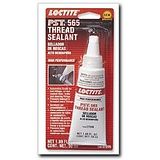 Oil choice
Oil choiceHarley Davidson products are the oils of choice:
* HD Multigrade SAE20W50 for the engine (in the UK)
* HD Sport Trans Fluid for the transmission
For the engine, oils of the same weight, directed at diesel engines, can be used.
Popular feeling is that synthetic oils are overkill.
FillingBoth transmission and engine oils are a bugger to fill.
Transmission oil is filled through the clutch inspection cover. One quart is sufficient and is EXACTLY the correct amount needed. To get the oil in, you can struggle with a funnel, however a better solution is to find an oil bottle with a spout, clean it out, and then transfer the Sport Trans Fluid to this bottle to enable filling. The transmission takes 32 fl ozs (0.95 litres) of HD Sprot Trans oil. I find the best way to fill it is to transfer the HD bottle contents to a bottle with a spout (in my case, a Castrol Two Stroke oil bottle), then inject the oil in. Another alternative is to use one of these caps (the red one with the removeable black nozzel end or one of the mini watering can ones with the end cut off):

Fits on to the Standard Formula 1 QT+ bottle thread.
Engine oil is filled through the filling hole on the swinging arm. It is easier to fill with the LHS rear footrest hanger removed, however some find that a flexible funnel does the job OK.

I made a *special* filling pipe using some 22mm copper pipe, two 45 deg elbows and a 22mm to 15mm reducer... It looks well out of place, but it does the job, either on paddock stand or side stand:
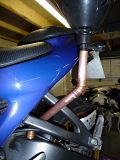

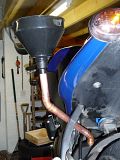
The reducer allows the pipe to *locate* in the filler hole...
The engine oil circuit takes 2.5 quarts (2.4 litres) (this includes the oil added to the filter on installation).
Checking levelsAn example of two departments working in isolation...
Engine oil needs to be checked with a warm engine, on the side stand. The level needs to be in between max and min on the dip stick with it screwed in. You can also save the trouble of screwing the dipstick in by identifying the required level by subtracting the length of the thread from the "upper" mark. This roughly corresponds to the "lower" mark. As the handbook says, the difference between these marks is 0.12 litres or 4 oz.
Transmission oil needs to be checked with the bike upright on level ground. When viewing through the clutch inspection cover, the level should just cover the bottom gear teeth, touching the bottom of the clutch diaphragm spring.
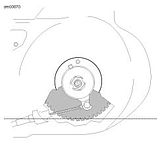
Note that the bike has to be upright on level ground. A paddock stand will result in the back wheel being higher than the front (unless you put blocks under the front wheel). Holding the bike upright and checking the oil yourself is asking for trouble (or help to get from underneath the bike)...


















